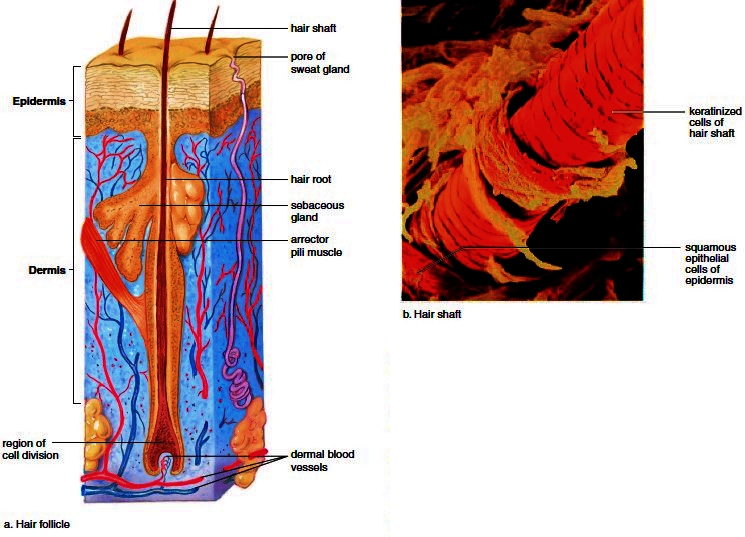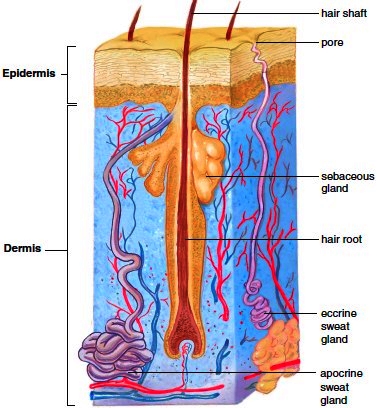Accessory Structures of the Skin
Hair, nails, and glands are structures of epidermal origin, even though some parts of hair and glands are largely in the dermis.
Hair and Nails
Hair is found on all body parts except the palms, soles, lips, nipples, and portions of the external reproductive organs. Most of this hair is fine and downy, but the hair on the head includes stronger types as well. After puberty, when sex hormones are made in quantity, there is noticeable hair in the axillary and pelvic regions of both sexes. In the male, a beard develops, and other parts of the body may also become quite hairy. When women produce more male sex hormone than usual, they can develop hirsutism, a condition characterized by excessive body and facial hair.

Hormonal injections and electrolysis to kill roots are possible treatments. Hairs project from complex structures called hair follicles. These hair follicles are formed from epidermal cells but are located in the dermis of the skin (Fig. 5.3). Certain hair follicle cells continually divide, producing new cells that form a hair. At first, the cells are nourished by dermal blood vessels, but as the hair grows up and out of the follicle, they are pushed farther away from this source of nutrients, become keratinized, and die. The portion of a hair within the follicle is called the root, and the portion that extends beyond the skin is called the shaft. The life span of any particular hair is usually three to four months for an eyelash and three to four years for a scalp hair; then it is shed and regrows. In males, baldness occurs when the hair on the head fails to regrow. Alopecia, meaning hair loss, can have many causes. Male pattern baldness, or androgenic alopecia, is an inherited condition. Alopecia areata is characterized by the sudden onset of patchy hair loss. It is most common among children and young adults, and can affect either sex. Each hair has one or more oil, or sebaceous, glands, whose ducts empty into the follicle. A smooth muscle, the arrector pili, attaches to the follicle in such a way that contraction of the muscle causes the hair to stand on end. If a person has had a scare or is cold, “goose bumps” develop due to contraction of these muscles.
Figure 5.3 Hair follicle and hair shaft. a. A hair grows from the base of a hair follicle where epidermal cells produce new cells as older cellsmove outward and become keratinized. b. A hair shaft penetrating the outer squamous epithelial cells of the epidermis.
Nails grow from special epithelial cells at the base of the nail in the region called the nail root (Fig. 5.4). These cells become keratinized as they grow out over the nail bed. The visible portion of the nail is called the nail body. The cuticle is a fold of skin that hides the nail root. Ordinarily, nails grow only about 1 millimeter per week. The pink color of nails is due to the vascularized dermal tissue beneath the nail. The whitish color of the half-moonshaped base, or lunula, results from the thicker germinal layer in this area.
Glands
The glands in the skin are groups of cells specialized to produce and secrete a substance into ducts.
Sweat Glands
Sweat glands, or sudoriferous glands, are present in all regions of the skin. There can be as many as 90 glands per square centimeter on the leg, 400 glands per square centimeter on the palms and soles, and an even greater number on the fingertips. A sweat gland is tubular. The tubule is coiled, particularly at its origin within the dermis. These glands become active when a person is under stress.
Glands
The glands in the skin are groups of cells specialized to produce and secrete a substance into ducts.
Sweat Glands
Sweat glands, or sudoriferous glands, are present in all regions of the skin. There can be as many as 90 glands per square centimeter on the leg, 400 glands per square centimeter on the palms and soles, and an even greater number on the fingertips. A sweat gland is tubular. The tubule is coiled, particularly at its origin within the dermis. These glands become active when a person is under stress.

Figure 5.4 Sagittal section of a nail. Cells produced by the nail root become keratinized, forming the nail body.

Two types of sweat glands are shown in Figure 5.5. Apocrine glands open into hair follicles in the anal region, groin, and armpits. These glands begin to secrete at puberty, and a component of their secretion may act as a sex attractant. Eccrine glands open onto the surface of the skin. They become active when a person is hot, helping to lower body temperature as sweat evaporates. The sweat (perspiration) produced by these glands is mostly water, but it also contains salts and some urea, a waste substance. Therefore, sweat is a form of excretion. Ears contain modified sweat glands, called ceruminous glands, which produce cerumen, or earwax.
Sebaceous Glands
Most sebaceous glands are associated with a hair follicle. These glands secrete an oily substance called sebum that flows into the follicle and then out onto the skin surface. This secretion lubricates the hair and skin, and helps waterproof them. Particularly on the face and back, the sebaceous glands may fail to discharge sebum, and the secretions collect, forming whiteheads or blackheads. If pus-inducing bacteria are also present, a boil or pimple may result. Acne vulgaris, the most common form of acne, is an inflammation of the sebaceous glands that most often occurs during adolescence. Hormonal changes during puberty cause the sebaceous glands to become more active at this time.
Sebaceous Glands
Most sebaceous glands are associated with a hair follicle. These glands secrete an oily substance called sebum that flows into the follicle and then out onto the skin surface. This secretion lubricates the hair and skin, and helps waterproof them. Particularly on the face and back, the sebaceous glands may fail to discharge sebum, and the secretions collect, forming whiteheads or blackheads. If pus-inducing bacteria are also present, a boil or pimple may result. Acne vulgaris, the most common form of acne, is an inflammation of the sebaceous glands that most often occurs during adolescence. Hormonal changes during puberty cause the sebaceous glands to become more active at this time.
Figure 5.5 Types of skin glands. Apocrine glands and eccrine glands are types of sweat glands.
Mammary Glands
The mammary glands are located within the breasts. A female breast contains 15 to 25 lobes, which are divided into lobules. Each lobule contains many alveoli. When milk is secreted, the milk enters a duct that leads to the nipple. Cells within the alveoli produce milk only after childbirth in response to complex hormonal changes occurring at that time.
The mammary glands are located within the breasts. A female breast contains 15 to 25 lobes, which are divided into lobules. Each lobule contains many alveoli. When milk is secreted, the milk enters a duct that leads to the nipple. Cells within the alveoli produce milk only after childbirth in response to complex hormonal changes occurring at that time.
Contacts: lubopitno_bg@abv.bg www.encyclopedia.lubopitko-bg.com Corporation. All rights reserved.
DON'T FORGET - KNOWLEDGE IS EVERYTHING!